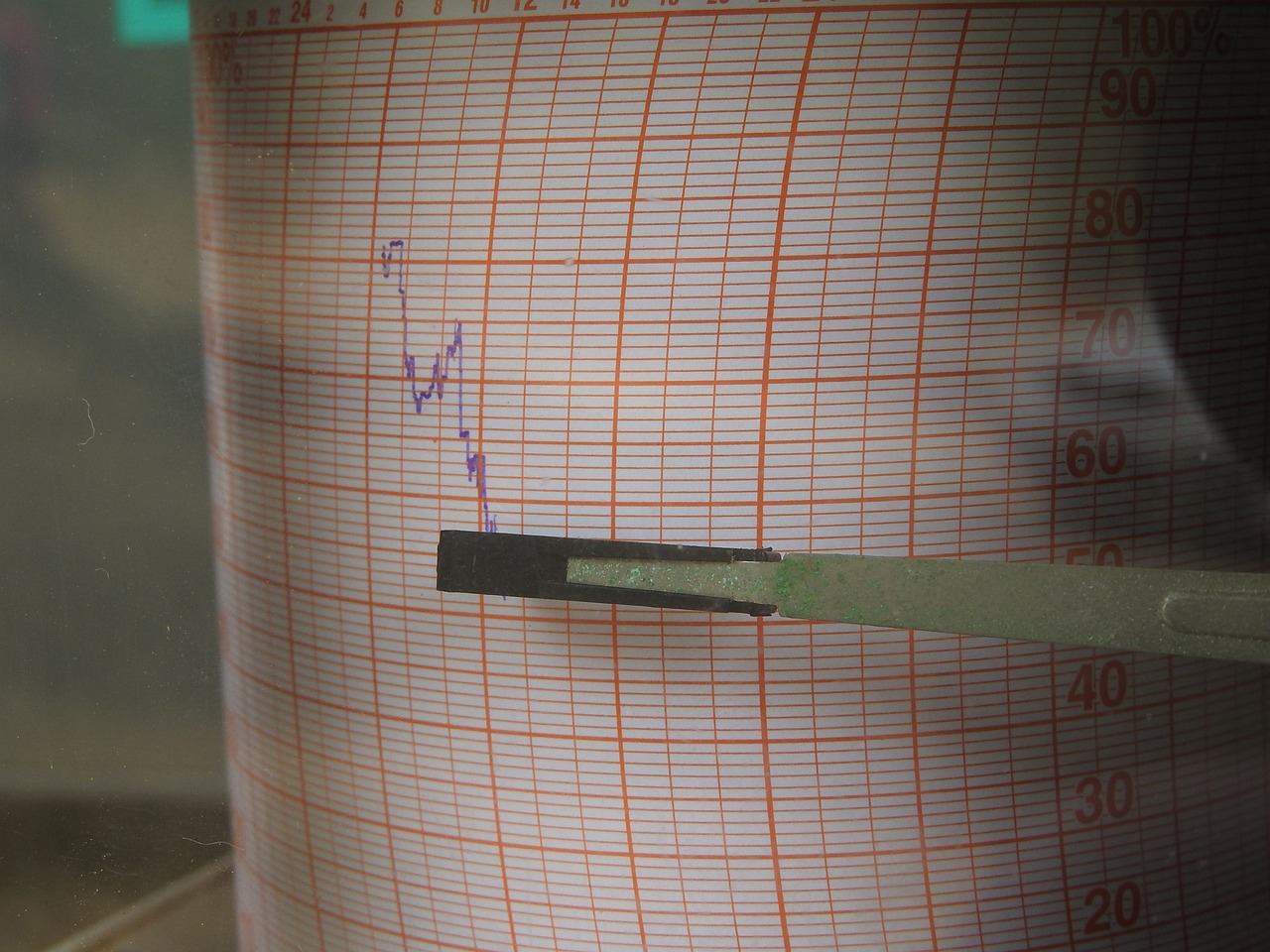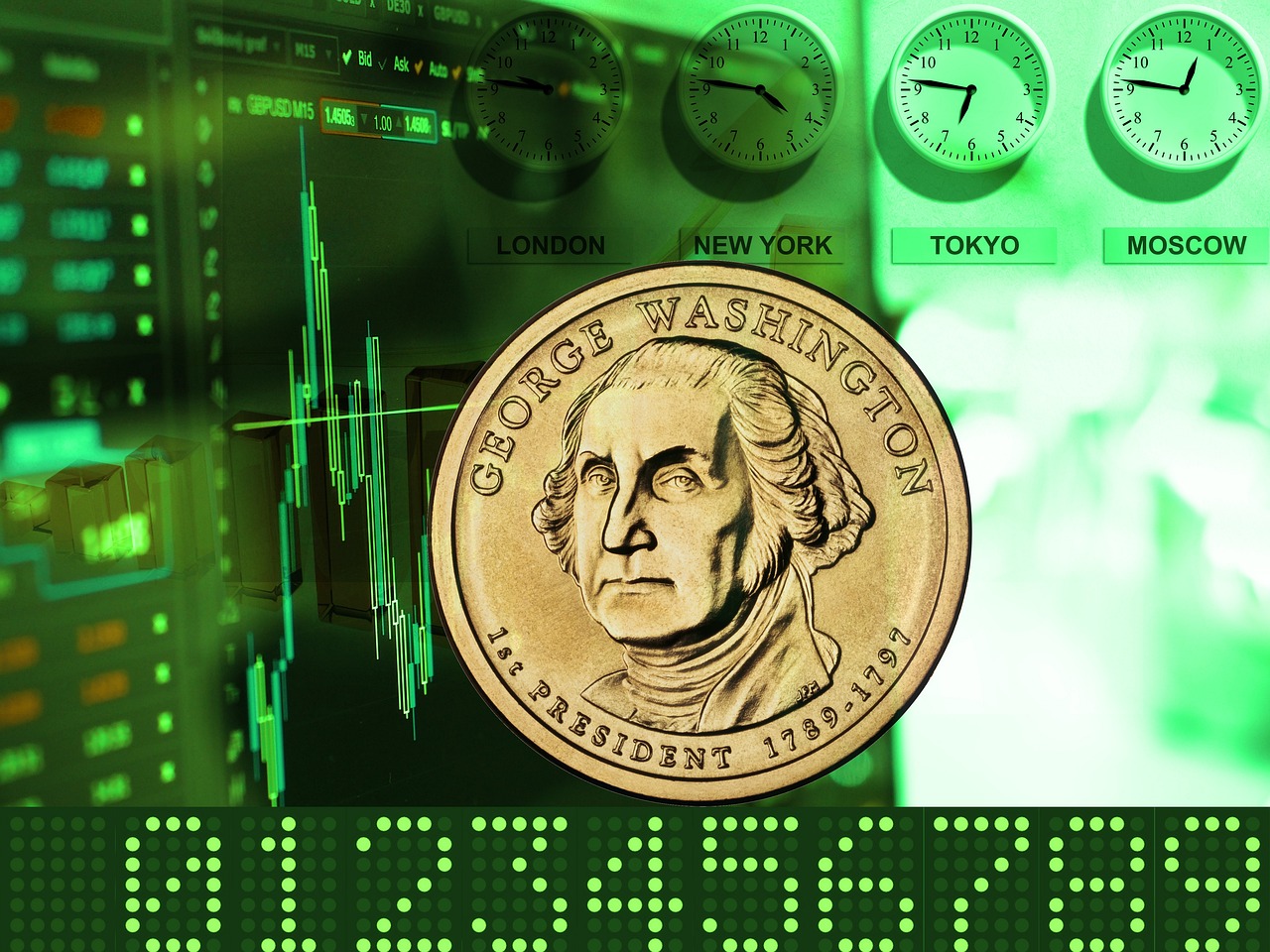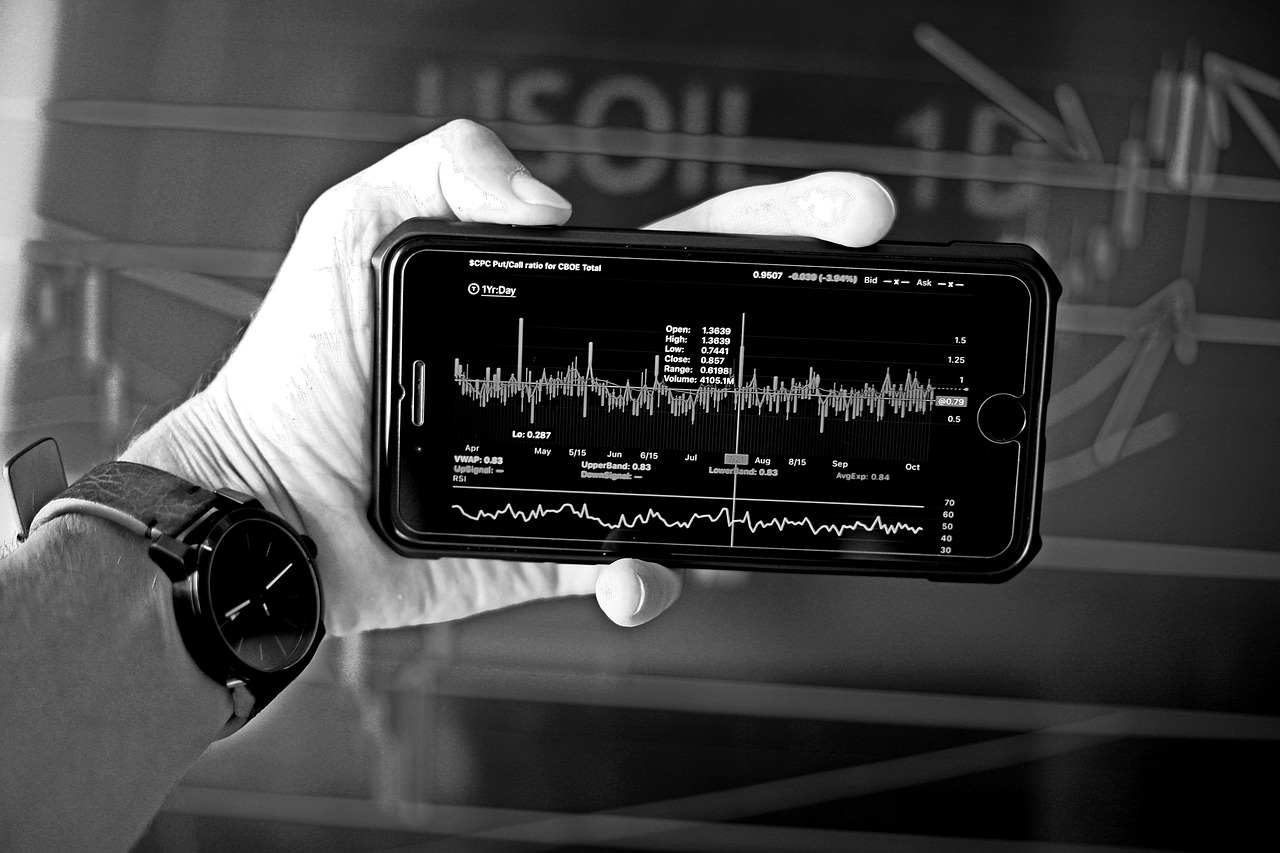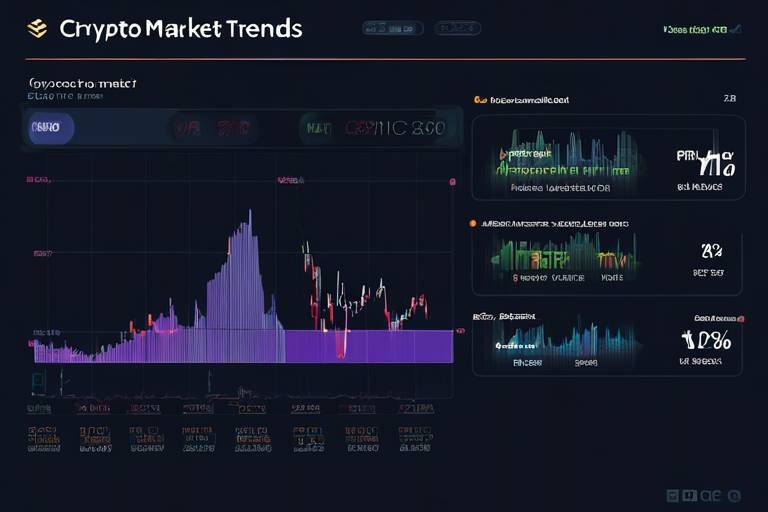How to Use Chart Indicators for Trading Success
In the world of trading, success isn't just about luck; it's about making informed decisions based on data. One of the most effective tools in a trader's arsenal is the use of chart indicators. These indicators can significantly enhance your trading strategies by providing insights into market trends, potential entry and exit points, and overall market sentiment. Imagine walking into a dense fog without a flashlight—this is how trading can feel without proper indicators. Chart indicators serve as your guiding light, illuminating the path to better trading decisions.
Chart indicators are essentially mathematical calculations derived from price, volume, or open interest data. They help traders analyze market trends and make informed decisions. But, how do you choose the right indicators? With so many options available, it can feel overwhelming. This article will break down the most commonly used indicators, explain their functionalities, and provide practical applications to help you achieve trading success.
To truly harness the power of chart indicators, you need to understand what they are and how they work. At their core, these indicators provide a visual representation of market data, allowing traders to identify patterns and trends that might not be immediately obvious. By analyzing these patterns, traders can make informed decisions about when to buy or sell an asset. Think of chart indicators as your trading compass; they guide you through the unpredictable waters of the market.
There are numerous types of chart indicators, each serving a unique purpose. Some of the most commonly used indicators fall into the following categories:
- Trend Indicators: These indicators help traders identify the direction of the market.
- Momentum Indicators: These gauge the speed of price movements, indicating potential reversals or continuations.
- Volatility Indicators: These measure market fluctuations and help traders understand price variability.
- Volume Indicators: These analyze trading volume to confirm trends and potential reversals.
Trend indicators are essential for traders looking to understand the market's direction. They help you determine whether the market is in a bullish or bearish phase. Two popular trend indicators are the Moving Averages and the Average Directional Index (ADX).
Moving Averages smooth out price data over a specific period, allowing traders to identify trends more easily. For instance, a 50-day moving average can help you see the overall trend by averaging the closing prices over the last 50 days. This is crucial for making timely trading decisions, as it helps confirm whether a trend is strengthening or weakening.
The ADX is a powerful tool that measures the strength of a trend, regardless of its direction. A rising ADX indicates a strong trend, while a falling ADX suggests a weak trend. Traders often use the ADX to determine whether to enter or exit a position based on the trend's strength. It’s like having a weather forecast for your trades—knowing when to expect a storm or a clear day can make all the difference.
Momentum indicators are designed to measure the speed of price movements, helping traders identify potential market reversals or continuations. The Relative Strength Index (RSI) and the Stochastic Oscillator are two common momentum indicators that traders rely on.
To maximize the effectiveness of chart indicators, it's essential to combine multiple indicators and adapt your strategies to different market conditions. Relying on a single indicator can lead to false signals and poor decision-making. Instead, think of it like cooking a gourmet meal: you need a variety of ingredients to create something truly delicious!
Using a combination of indicators can provide a more comprehensive view of the market. For instance, pairing a trend indicator with a momentum indicator can help you confirm potential trade setups. This approach filters out false signals and enhances your chances of successful trades. Just like a team of experts working together, combining indicators can lead to better outcomes.
Understanding the signals generated by chart indicators is crucial. Each indicator has its own set of signals, such as buy and sell signals. Context is key; for example, a buy signal from an RSI might not be as strong if the overall trend is bearish. Thus, always consider the broader market conditions before making a decision. It's like reading a book: you need to grasp the overall plot before diving into the details.
Even seasoned traders can fall into traps when using chart indicators. Some common mistakes include:
- Relying too heavily on one indicator.
- Ignoring market conditions and news events.
- Failing to adapt strategies to changing market dynamics.
To avoid these pitfalls, always conduct thorough research and remain flexible in your trading approach. Remember, the market is constantly evolving, and so should your strategies.
1. What are chart indicators?
Chart indicators are mathematical calculations based on price, volume, or open interest that help traders analyze market trends and make informed trading decisions.
2. How do I choose the right indicators?
Choosing the right indicators depends on your trading style and goals. It's often best to combine different types of indicators for a more comprehensive analysis.
3. Can I rely on one indicator?
While some traders may find success with a single indicator, it's generally advisable to use a combination to filter out false signals and improve your trading accuracy.
4. How do I interpret signals from indicators?
Interpreting signals requires understanding the context. Always consider broader market trends and conditions when analyzing buy or sell signals.
5. What are common mistakes to avoid when using indicators?
Common mistakes include relying too heavily on one indicator, ignoring market conditions, and failing to adapt strategies to changing dynamics.

Understanding Chart Indicators
Chart indicators are essential tools in the world of trading, acting like a compass that guides traders through the often turbulent waters of financial markets. These indicators are essentially mathematical calculations derived from various market data points, including price, volume, and open interest. By analyzing these indicators, traders can gain valuable insights into market trends, helping them to identify optimal entry and exit points for their trades.
Think of chart indicators as a set of glasses that allows you to see the market more clearly. Without them, you might be stumbling around in the dark, making decisions based on gut feelings rather than solid data. The primary purpose of these indicators is to help traders make informed decisions by interpreting the complex movements of the market. They can reveal whether a market is trending upward, downward, or moving sideways, and they can also indicate the strength of these movements.
There are different types of chart indicators, each serving a unique purpose. For instance, some indicators focus on identifying trends, while others gauge momentum or measure volatility. Understanding the functionality of these indicators is crucial for any trader looking to enhance their trading strategies. Here’s a brief overview of the main categories:
- Trend Indicators: These help identify the overall direction of the market.
- Momentum Indicators: These measure the speed of price movements and help predict potential reversals.
- Volatility Indicators: These gauge the degree of price fluctuations in the market.
- Volume Indicators: These analyze the number of shares or contracts traded, providing insight into market strength.
By mastering the art of reading these indicators, traders can significantly improve their chances of making profitable trades. However, it's important to remember that no single indicator is foolproof. Instead, successful traders often combine multiple indicators to form a more comprehensive view of the market. This multi-faceted approach not only enhances the accuracy of their predictions but also helps them avoid the common pitfalls associated with relying on a single source of information.
In conclusion, understanding chart indicators is a foundational skill for any trader. By using these mathematical tools effectively, traders can navigate the complexities of the market with greater confidence and precision. Just as a skilled sailor uses a compass and a map to chart their course, savvy traders can leverage chart indicators to steer their trading strategies towards success.

Types of Chart Indicators
When it comes to trading, understanding the different types of chart indicators is crucial for crafting effective strategies. Chart indicators can be broadly categorized into several types, each serving a unique purpose and offering valuable insights into market behavior. By leveraging these indicators, traders can make informed decisions that align with their trading goals. Let's dive into the major categories of chart indicators that every trader should be familiar with.
The first type is trend indicators, which are essential for identifying the direction of the market. These indicators help traders determine whether the market is in an uptrend, downtrend, or sideways movement. Popular examples include the Moving Averages and the Average Directional Index (ADX). Moving Averages smooth out price fluctuations over a specific period, allowing traders to visualize trends more clearly. On the other hand, the ADX measures the strength of a trend, regardless of whether it is bullish or bearish, providing traders with insights on when to enter or exit a position.
Next, we have momentum indicators, which focus on the speed of price movements. These indicators are particularly useful for identifying potential reversals and continuations in the market. The Relative Strength Index (RSI) and the Stochastic Oscillator are two commonly used momentum indicators. The RSI measures the speed and change of price movements, helping traders identify overbought or oversold conditions. Meanwhile, the Stochastic Oscillator compares a specific closing price to a range of prices over a certain period, providing insights into potential trend reversals.
Another important category is volatility indicators. These indicators measure the degree of variation in trading prices, helping traders understand how much the price of an asset is likely to fluctuate. Common volatility indicators include the Average True Range (ATR) and the Bollinger Bands. The ATR quantifies market volatility by decomposing the entire range of an asset's price for a given period. Bollinger Bands, on the other hand, consist of a moving average and two standard deviation lines, which adjust based on market volatility, helping traders identify potential price breakouts.
Lastly, we have volume indicators, which provide insights into the strength of price movements by analyzing the trading volume. Volume is a key component in confirming trends; if a price movement is accompanied by high volume, it is generally considered more reliable. Indicators like the On-Balance Volume (OBV) and the Accumulation/Distribution Line are popular choices among traders. The OBV adds volume on up days and subtracts it on down days, creating a cumulative line that helps traders gauge buying and selling pressure.
In summary, understanding the different types of chart indicators is essential for any trader looking to enhance their trading strategies. By familiarizing yourself with trend, momentum, volatility, and volume indicators, you can gain a comprehensive view of the market and make more informed trading decisions. Remember, the key to successful trading lies in combining these indicators effectively, interpreting their signals accurately, and adapting your strategies to the ever-changing market conditions.

Trend Indicators
Trend indicators are essential tools for traders who want to navigate the often turbulent waters of the financial markets. They serve as a compass, helping you to identify the direction in which a market is moving—be it upwards, downwards, or sideways. By understanding these indicators, you can make more informed decisions about when to enter or exit trades. Imagine you’re sailing a ship; without a compass, you might drift aimlessly. Trend indicators provide that necessary guidance, allowing you to chart a course toward potential profits.
Among the most popular trend indicators are Moving Averages and the Average Directional Index (ADX). Each of these indicators has its unique characteristics and serves different purposes, but both can significantly enhance your trading strategy when used correctly. Let’s dive deeper into these two powerful tools.
Moving Averages are perhaps the most widely used trend indicators in trading. They work by averaging price data over a specific time period, which helps to smooth out price fluctuations and identify the overall direction of the trend. For instance, if you’re looking at a 50-day moving average, you’re essentially looking at the average price of an asset over the last 50 days. This can help you see whether the price is trending upwards or downwards. Traders often use two moving averages—a shorter one and a longer one—to identify potential buy and sell signals. When the shorter moving average crosses above the longer one, it may indicate a bullish trend, while a cross below might suggest a bearish trend.
The Average Directional Index (ADX) is another powerful tool that measures the strength of a trend, regardless of its direction. Unlike Moving Averages, which can indicate whether a trend is up or down, the ADX focuses solely on the strength of that trend. Typically, an ADX reading above 20 suggests a strong trend, while a reading below 20 indicates a weak trend. This information is invaluable for traders looking to determine whether to enter a position. For example, if the ADX is rising above 20, it might be a good time to consider entering a trade in the direction of the trend.
| Indicator | Purpose | Key Features |
|---|---|---|
| Moving Averages | Identify the direction of the trend | Smooths out price data, uses short and long periods |
| Average Directional Index (ADX) | Measure the strength of a trend | Indicates trend strength, ranges from 0 to 100 |
In summary, utilizing trend indicators like Moving Averages and the ADX can provide traders with a clearer picture of market dynamics. They help you to identify not just the direction of the market but also the strength of the trend, enabling you to make more strategic trading decisions. So, the next time you’re analyzing a chart, remember to keep an eye on these indicators—they might just be the key to unlocking your trading success!

Moving Averages
Moving Averages are among the most popular and widely used chart indicators in the trading world. They play a critical role in helping traders smooth out price data, thereby allowing for a clearer view of market trends over a specified period. Think of Moving Averages as a way to filter out the "noise" of daily price fluctuations, much like how a calm lake reflects a serene sky without the ripples of wind. By averaging price data, these indicators help traders identify whether a stock is in an uptrend, downtrend, or moving sideways.
There are two primary types of Moving Averages: the Simple Moving Average (SMA) and the Exponential Moving Average (EMA). Each serves a unique purpose and offers different insights:
- Simple Moving Average (SMA): This calculation takes the average price of an asset over a specific number of periods. For example, a 10-day SMA would average the closing prices of the last 10 days. While it is straightforward and easy to understand, it can lag behind the current price action, making it less responsive to sudden market changes.
- Exponential Moving Average (EMA): This variant gives more weight to recent prices, making it more sensitive to new information. For traders looking to capture quick market movements, the EMA can be a better choice as it reacts faster to price changes.
One of the key benefits of using Moving Averages is their ability to act as dynamic support and resistance levels. When the price of an asset crosses above its Moving Average, it may indicate a bullish trend, while a drop below the Moving Average could signal a bearish trend. However, traders should be cautious; these indicators can produce false signals, especially in choppy or sideways markets. It’s essential to combine Moving Averages with other indicators or analysis techniques to increase the reliability of the signals.
To illustrate the effectiveness of Moving Averages, consider the following hypothetical example:
| Day | Closing Price | 10-Day SMA |
|---|---|---|
| 1 | $100 | |
| 2 | $102 | |
| 3 | $101 | |
| 4 | $105 | |
| 5 | $107 | |
| 6 | $110 | |
| 7 | $109 | |
| 8 | $111 | |
| 9 | $115 | |
| 10 | $117 | $107.3 |
In this table, you can see how the 10-day SMA is calculated. As the days progress, the SMA adjusts, providing a clearer picture of the prevailing trend. Traders often use crossovers, where the short-term Moving Average crosses above or below the long-term Moving Average, as potential buy or sell signals.
In summary, Moving Averages are invaluable tools for traders looking to enhance their market analysis. By smoothing out price data and providing dynamic support and resistance levels, they can help traders make more informed decisions. Just remember, while they can be powerful, they are not foolproof. Always consider using them in conjunction with other indicators and analysis methods to bolster your trading strategy.

Average Directional Index (ADX)
The is a powerful tool in the arsenal of traders looking to gauge the strength of a trend, regardless of its direction. Imagine standing at a crossroads, unsure whether to go left or right. The ADX acts like a compass, guiding you by indicating whether the market is trending strongly or moving sideways. Developed by J. Welles Wilder, this indicator is particularly useful for traders who want to avoid choppy markets and focus on more stable price movements.
The ADX is typically plotted as a single line on a chart, with values ranging from 0 to 100. When the ADX is below 20, it suggests a weak trend or a ranging market, while readings above 25 indicate a strong trend. Traders often interpret these values as follows:
| ADX Value | Interpretation |
|---|---|
| 0 - 20 | Weak trend or sideways movement |
| 20 - 25 | Potential trend starting |
| 25 - 50 | Strong trend |
| 50 - 75 | Very strong trend |
| 75 - 100 | Extreme trend strength |
One of the most effective ways to utilize the ADX is to combine it with other indicators, like the +DI and -DI lines, which represent the directional movement. The +DI measures the strength of the upward movement, while the -DI measures the strength of the downward movement. When the +DI crosses above the -DI, it signals a potential buying opportunity, suggesting that the market is likely to trend upwards. Conversely, when the -DI crosses above the +DI, it may indicate a selling opportunity, hinting at a downward trend.
Moreover, the ADX does not indicate the direction of the trend; it solely measures its strength. Therefore, traders should be cautious and not solely rely on the ADX for their trading decisions. Instead, it's wise to incorporate other tools and analysis methods to confirm signals before making any trades. For instance, combining the ADX with support and resistance levels can provide a more comprehensive view of potential price movements.
In summary, the ADX is an invaluable indicator for traders who want to understand the strength of market trends. By interpreting its values correctly and using it alongside other indicators, traders can enhance their decision-making process and improve their chances of success in the often unpredictable world of trading.

Momentum Indicators
Momentum indicators are essential tools in a trader’s arsenal, designed to measure the speed and strength of price movements. Think of them as the pulse of the market, helping you gauge whether a price trend is gaining momentum or losing steam. By analyzing momentum, traders can spot potential reversals or continuations in price trends, which can be critical for making informed trading decisions. Two of the most popular momentum indicators are the Relative Strength Index (RSI) and the Stochastic Oscillator.
The Relative Strength Index (RSI) is a powerful momentum oscillator that ranges from 0 to 100. It helps traders identify overbought or oversold conditions in the market. Typically, an RSI above 70 indicates that an asset may be overbought, while an RSI below 30 suggests it could be oversold. This information can be invaluable when deciding whether to enter or exit a trade. For instance, if the RSI is showing an overbought condition, traders might consider selling, anticipating a price correction. On the flip side, an oversold RSI could signal a buying opportunity.
On the other hand, the Stochastic Oscillator compares a particular closing price of an asset to a range of its prices over a specific period. This indicator also ranges from 0 to 100 and is typically used to identify overbought and oversold levels. A reading above 80 indicates overbought conditions, while a reading below 20 indicates oversold conditions. The beauty of the Stochastic Oscillator lies in its ability to provide signals about potential price reversals, especially when combined with other indicators.
To illustrate how these indicators work in practice, consider the following table that summarizes their key features:
| Indicator | Range | Overbought Level | Oversold Level | Application |
|---|---|---|---|---|
| Relative Strength Index (RSI) | 0 - 100 | Above 70 | Below 30 | Identifies potential buy/sell signals based on price momentum |
| Stochastic Oscillator | 0 - 100 | Above 80 | Below 20 | Indicates potential reversals based on closing prices |
When using momentum indicators, it's crucial to remember that no single indicator is foolproof. They are best utilized in conjunction with other analytical tools to confirm signals and enhance decision-making. For example, if the RSI indicates an overbought condition while the Stochastic Oscillator also shows overbought levels, it could strengthen the case for a potential price reversal. However, if one indicator suggests a buy signal while another indicates a sell signal, it might be wise to wait for further confirmation before acting.
In conclusion, momentum indicators like the RSI and Stochastic Oscillator are vital for traders looking to capitalize on market movements. By understanding how these indicators work and applying them effectively, you can improve your trading strategies and make more informed decisions. Remember, the key to successful trading often lies in the ability to interpret and act upon the signals provided by these indicators, while also considering the broader market context.
- What are momentum indicators?
Momentum indicators are tools used to measure the speed and strength of price movements in the market. - How do I use the Relative Strength Index (RSI)?
The RSI can be used to identify overbought or oversold conditions, helping traders decide when to buy or sell. - Can I rely on just one momentum indicator?
While one indicator can provide useful insights, it's often best to use multiple indicators for confirmation and to avoid false signals. - What is the best way to combine momentum indicators?
Combining indicators like the RSI and Stochastic Oscillator can provide a more comprehensive view of market conditions and potential trading opportunities.

Using Chart Indicators Effectively
When it comes to trading, using chart indicators effectively can make all the difference between success and failure. Think of chart indicators as your personal GPS in the vast and often unpredictable world of trading. They guide you through the twists and turns of market movements, helping you make informed decisions. However, just like a GPS, if you don’t know how to interpret the directions, you might end up lost. So, how can you harness the power of these indicators to enhance your trading strategy?
One of the most effective ways to use chart indicators is by combining multiple indicators. This is akin to having a multi-layered approach to understanding the market. By using a combination of trend, momentum, and volatility indicators, you can gain a more comprehensive view of market conditions. For example, if you’re using a Moving Average to identify the trend and the Relative Strength Index (RSI) to gauge momentum, you’re not just relying on one piece of information. This layered strategy helps filter out noise and reduces the chances of falling for false signals.
Understanding how to interpret the signals generated by these indicators is equally crucial. When a trend indicator suggests a buy signal, it’s essential to consider the context. Is the market in a strong bullish phase, or are there signs of potential reversal? This is where your analytical skills come into play. For instance, if the Moving Average indicates an upward trend but the RSI shows overbought conditions, it might be wise to wait for a confirmation before jumping into a trade.
Moreover, adapting your strategies to different market conditions is vital. Markets are not static; they evolve, and so should your approach. During volatile periods, certain indicators might give misleading signals. For instance, in a choppy market, trend indicators can produce whipsaws, leading to unnecessary losses. Therefore, being flexible and adjusting your indicators based on the current market environment can significantly enhance your trading success.
To further illustrate the effectiveness of using chart indicators, let’s look at a simple table that summarizes how different indicators can be combined for better decision-making:
| Indicator Type | Example Indicators | Purpose |
|---|---|---|
| Trend Indicators | Moving Averages, ADX | Identify market direction |
| Momentum Indicators | RSI, Stochastic Oscillator | Gauge the speed of price movements |
| Volatility Indicators | Bollinger Bands, ATR | Measure market volatility |
| Volume Indicators | Volume, On-Balance Volume | Confirm price movements |
In conclusion, using chart indicators effectively requires a combination of knowledge, skill, and adaptability. By layering your indicators, interpreting signals within context, and adjusting your strategies according to market conditions, you can navigate the trading landscape with greater confidence. Remember, trading is not just about following the numbers; it’s about understanding the story behind those numbers.
- What are chart indicators? Chart indicators are mathematical calculations based on price, volume, or open interest that help traders analyze market trends.
- How do I choose the right indicators? Choose indicators that align with your trading style and the market conditions you are facing. Combining different types can offer a more comprehensive view.
- Can I rely on just one indicator? It is not advisable to rely on a single indicator, as this can lead to false signals. A combination of indicators provides a better analysis.
- What should I do if the indicators give conflicting signals? In such cases, consider the overall market context and your trading strategy. It may be wise to wait for clearer signals before making a decision.

Combining Indicators
When it comes to trading, the adage "two heads are better than one" rings true, especially in the world of chart indicators. By , traders can gain a more nuanced understanding of market dynamics, which can significantly enhance their decision-making process. Imagine trying to navigate through a dense fog; having multiple sources of light can help you see your path clearly. Similarly, using a variety of indicators can illuminate different aspects of market behavior, allowing for more informed trading strategies.
One popular method is to blend trend indicators with momentum indicators. For instance, a trader might use a Moving Average to establish the overall trend and then apply the Relative Strength Index (RSI) to pinpoint potential entry and exit points. This combination allows traders to confirm that they are not only trading in the direction of the prevailing trend but also timing their entries effectively. It’s like having a compass and a map; one tells you where you are going, and the other helps you navigate the terrain.
However, it's important to be cautious. Using too many indicators can lead to analysis paralysis, where traders become overwhelmed with conflicting signals. To avoid this, focus on a select few indicators that complement each other. For example, a trader might choose to use the Moving Average Convergence Divergence (MACD) alongside the Average True Range (ATR). The MACD provides insights into momentum and trend direction, while the ATR measures market volatility, helping traders to adjust their strategies based on how much the price is likely to move.
Here's a quick summary of how these indicators can work together:
| Indicator Type | Indicator | Purpose |
|---|---|---|
| Trend | Moving Average | Identifies the direction of the trend |
| Momentum | Relative Strength Index (RSI) | Indicates overbought or oversold conditions |
| Volatility | Average True Range (ATR) | Measures market volatility |
| Trend & Momentum | MACD | Shows momentum and potential reversals |
In conclusion, the art of combining indicators is not just about adding more tools to your trading toolkit; it's about creating a harmonious relationship between them. By understanding how different indicators interact, traders can filter out noise and hone in on high-probability setups. Remember, the goal is to enhance your trading strategy, not complicate it. So, take the time to experiment with various combinations and find what works best for you. After all, every trader's journey is unique, and the right combination of indicators can make all the difference in achieving trading success.
- What are chart indicators?
Chart indicators are mathematical calculations based on price, volume, or open interest that help traders analyze market trends and make informed decisions.
- Why should I combine indicators?
Combining indicators can provide a more comprehensive view of market conditions, helping to confirm signals and improve trading accuracy.
- How many indicators should I use?
It's best to use a select few indicators that complement each other to avoid confusion and analysis paralysis.
- Can I rely on indicators alone for trading?
While indicators are helpful, they should not be the sole basis for trading decisions. Always consider market conditions and other factors.

Interpreting Signals
When it comes to trading, understanding how to interpret signals from chart indicators is crucial for making informed decisions. Just like a traffic light that tells you when to stop or go, chart indicators provide vital information about market movements. However, interpreting these signals isn't always straightforward; it requires a keen eye and an understanding of the context in which they appear. For instance, a signal might suggest a buying opportunity, but if the overall market sentiment is bearish, it might be wise to hold off.
To effectively interpret signals, traders need to recognize the different types of signals that indicators can generate. Here are some key signals to look out for:
- Buy Signals: Often indicated by a crossover in moving averages or a bullish divergence in momentum indicators like the RSI. This suggests that the asset may be gaining strength and could be a good time to enter a position.
- Sell Signals: Typically identified when the price crosses below a moving average or when indicators show overbought conditions. These signals indicate that it might be time to take profits or cut losses.
- Neutral Signals: Sometimes, indicators can show no clear direction, suggesting that the market is consolidating. In such cases, it’s essential to wait for a more definitive signal before making a move.
Moreover, context is everything. A signal that appears strong in one market condition might be weak in another. For example, during a strong bullish trend, a pullback might trigger a sell signal, but it could also present a buying opportunity for savvy traders. Therefore, it’s essential to analyze the broader market context and not rely solely on the signals from your indicators.
Another important aspect of interpreting signals is the time frame you are analyzing. Short-term traders might focus on minute or hourly charts, while long-term investors may look at daily or weekly charts. The signals can vary significantly based on the time frame, so it’s vital to align your trading strategy with the appropriate chart. By doing so, you can better gauge the reliability of the signals and make more informed trading decisions.
In summary, interpreting signals from chart indicators requires a blend of technical knowledge and market awareness. By understanding the types of signals, considering the market context, and aligning your analysis with the appropriate time frames, you can enhance your trading strategy and improve your chances of success. Remember, trading is as much an art as it is a science, so don’t hesitate to trust your instincts while complementing them with analytical data.
- What are chart indicators?
Chart indicators are mathematical tools used to analyze price movements and trends in financial markets. They help traders make informed decisions based on historical data. - How do I choose the right indicators for my trading strategy?
Choosing the right indicators depends on your trading style, time frame, and market conditions. It's often beneficial to combine multiple indicators to get a more comprehensive view. - Can I rely on just one indicator?
No, relying solely on one indicator can be risky. It's essential to consider multiple indicators and the overall market context to make informed trading decisions. - How often should I check my indicators?
This depends on your trading style. Day traders may check indicators frequently throughout the day, while long-term investors might review them weekly or monthly.

Common Mistakes to Avoid
When it comes to trading, even the most skilled traders can fall into traps that can derail their success. One of the most common mistakes is relying on a single indicator to make trading decisions. While it might seem tempting to focus on one tool, this approach often leads to misinterpretations of market conditions. Imagine trying to navigate a complex maze using only one direction; you might miss the bigger picture and end up lost. Instead, consider using a combination of indicators to create a more rounded perspective.
Another frequent pitfall is ignoring market conditions. Just because an indicator signals a buy doesn’t mean it’s the right time to jump in. For instance, if the market is experiencing high volatility, it might be wise to hold off on trades, even if your indicators are flashing green. Think of it like driving a car; if the weather is stormy, you wouldn’t drive at full speed just because the road looks clear ahead. Always assess the overall environment before making decisions.
Additionally, many traders fail to set proper risk management strategies. Without a solid plan for managing risk, traders can easily find themselves in deep waters. For example, setting stop-loss orders is crucial; they act like safety nets, protecting you from significant losses. If you neglect this step, a bad trade can quickly turn into a disaster. It’s essential to define how much you are willing to lose on any given trade and stick to that limit.
Another common mistake is overtrading. In the heat of the moment, traders often feel the urge to make numerous trades, thinking they can maximize profits. However, this can lead to exhaustion and poor decision-making. Imagine trying to juggle too many balls at once; eventually, something is bound to drop. Instead, focus on quality over quantity. Take your time to analyze each trade carefully and only act when the conditions are right.
Lastly, it’s crucial to avoid emotional trading. Decisions driven by fear or greed can cloud your judgment and lead to impulsive actions. When you allow emotions to dictate your trades, you’re more likely to make mistakes that could have been easily avoided. To counter this, develop a trading plan and stick to it. This plan should include your trading goals, risk tolerance, and the criteria for entering and exiting trades. By having a clear roadmap, you can navigate the trading landscape with confidence.
Q: What is the most common mistake traders make?
A: The most common mistake is relying on a single indicator for trading decisions. It's important to use multiple indicators to get a comprehensive view of the market.
Q: How can I avoid emotional trading?
A: To avoid emotional trading, develop a clear trading plan that outlines your goals and criteria for making trades. Stick to this plan to minimize impulsive decisions.
Q: Why is risk management important?
A: Risk management is crucial because it helps protect your capital from significant losses. Setting stop-loss orders and defining your risk tolerance are key strategies in managing risk.
Q: How do I know if I'm overtrading?
A: If you find yourself making too many trades without proper analysis or if you feel exhausted from constantly monitoring the market, you may be overtrading. Focus on quality trades instead.
Frequently Asked Questions
- What are chart indicators?
Chart indicators are mathematical tools that analyze price, volume, or open interest data. They help traders identify market trends, entry and exit points, and make informed trading decisions.
- How do I choose the right chart indicators for my trading strategy?
Choosing the right indicators depends on your trading style and goals. For trend trading, you might use Moving Averages or the ADX, while momentum traders often prefer the RSI or Stochastic Oscillator. Experimenting with different indicators can help you find what works best for you.
- Can I rely on just one indicator for trading decisions?
Relying on a single indicator can be risky. It's better to combine multiple indicators to get a more comprehensive view of the market and filter out false signals. This way, you can make more confident trading decisions.
- What is the importance of understanding market conditions when using chart indicators?
Understanding market conditions is crucial because indicators can give misleading signals during different market phases. For example, an indicator might suggest a buy signal in a choppy market, but the conditions could lead to losses. Always consider the broader market context.
- What are some common mistakes traders make with chart indicators?
Some common mistakes include over-relying on one indicator, ignoring market conditions, and not adapting strategies based on changing trends. To avoid these pitfalls, it's essential to stay informed and flexible in your approach.
- How can I interpret buy and sell signals from chart indicators?
Interpreting buy and sell signals involves understanding the specific indicators you are using. For instance, a buy signal from the RSI occurs when it crosses above a certain threshold, while a sell signal may happen when it drops below another. Always look for confirmation from other indicators to enhance your decision-making.



















